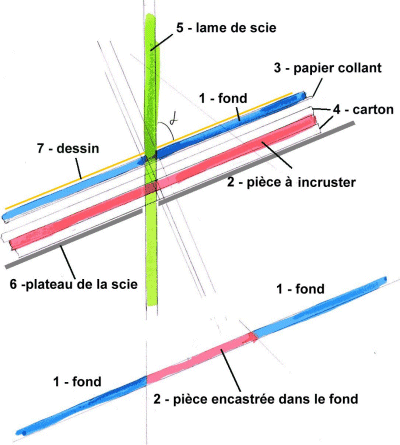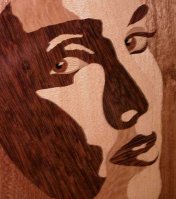
CONIC CUTTING METHOD
by Pierre GABORIAUD de LA TOUR, Mont de Marsan (40)

This extraordinarily precise method allows a big freedom of cutting.
Indeed, the precise follow-up of the line is not useful because one cuts of the same blow both parts of the marquetry.
In the method of conical cut, both details are cut at the same time. But unlike the method BOULLE, the tray is oblique. Details fit so perfectly without the slightest set in no direction, by simple conical fitting of the smallest detail (below, in red) which penetrates into the biggest (above, in blue) as a corner.
The rigour of the joint depends for the greater part on laws of the geometry, and the appreciation of certains parameters on behalf of the one that practises this cut.
The inlayer will proceed by experience, and will fast discover the regulations to take into account differences of angle according to the thickness of veneers combined in the thickness of the blade : one can say that the basic angle alpha is from 11 to 12░ for woods between 6 to 9 1/10 mm, more for thinker woods.
 For example, on a square patch 1, one wants to inlay a circle of different wood 4. One places down the wooden sheet 4 which will give the circle, then the overcoat the one that will be the outline 1. One inserts veneers of protection 3 and 5.
Once these patches were assembled, one drills a small hole of the size of the blade, one fixes and one tightens the blade 6 on the frame. If the tray is tilted towards the left, one cuts the circle by turning clockwise.
At the end of the cut, the blade is unsettled, the top circle is thrown, that of the bottoms by going back up fits perfectly, because the conicity compensates for the width of the passage of the blade (less than 3 / 10 mm).
For example, on a square patch 1, one wants to inlay a circle of different wood 4. One places down the wooden sheet 4 which will give the circle, then the overcoat the one that will be the outline 1. One inserts veneers of protection 3 and 5.
Once these patches were assembled, one drills a small hole of the size of the blade, one fixes and one tightens the blade 6 on the frame. If the tray is tilted towards the left, one cuts the circle by turning clockwise.
At the end of the cut, the blade is unsettled, the top circle is thrown, that of the bottoms by going back up fits perfectly, because the conicity compensates for the width of the passage of the blade (less than 3 / 10 mm).
Every cut element is immediately set up, its sticking is made on the slice by some white glue "express". The implementation is made in flat by compressing well the detail which one can maintain by means of gummed paper 2 So embeded, a detail of modest size stays perfectly in place until the complete drying, and allows again the sawing of a new one.
In the square sheet of the departure, following successive inlays, the wood of origin will be replaced bit by bit, and grows rich of motives, by forms and by nuances.
It drives to think more of a sort of replacement of the material than an assembly, because it is detail after detail that the picture builds itself.
The conical cut can concern only a single picture realized at first on a single in theory whole and wooden sheet, and of definitive size

 Realizations of the author according to this technique
Realizations of the author according to this technique
